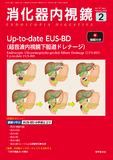Japanese
English
- 有料閲覧
- Abstract 文献概要
- 1ページ目 Look Inside
- 参考文献 Reference
要旨
超音波内視鏡下胆道ドレナージ(EUS-BD)は2001年に初めて報告されてから20年以上が経過しており成熟した手技になりつつある。EUS-BDの工程はまず対象となる胆管をコンベックス型EUSスコープで描出し,穿刺ラインの確保,介在血管の確認などを行い,EUS-FNA針を用いて穿刺,造影,ガイドワイヤー留置を行い,胃壁胆管壁の拡張を行い,ステントを留置する,というものである。近年の最も大きなアップデートはEUS-BDを念頭においたコンベックス型EUSスコープの開発であり,EUS-HGSに関しては安全確実に胃内からB2穿刺を行うことが可能となった。ガイドワイヤーは多種多様性の時代であり,状況に応じてベストなガイドワイヤーを選択することが可能となった。胃壁胆管壁拡張もデバイスの開発により安全確実に行うことが可能になった。10年前には存在しなかったEUS-BDの保険収載がついている金属ステントも販売される時代になっている。ただしEUS-BDに関しては,まずその適応を十分に吟味し,本当にEUS-BDが行われるべき症例であるかを検討することが重要であることは現在も変わりはない。デバイスがいくら発達したとしても,適応のない症例に誤って用いることは絶対に避けなければならない。さらにデバイスの開発はとてつもないスピードで行われており,EUS-BDを行う胆膵内視鏡医は常にアンテナを立て,少しでも確実で安全なEUS-BDを行うべく知識のアップデートを行い続けなくてはならない。
More than 20 years have passed since EUS-BD was first reported in 2001, and EUS-BD is becoming a mature procedure. The process of EUS-BD involves first using a convex-type EUS scope to visualize the target bile duct, then securing a puncture line, checking for intervening blood vessels, and using an EUS-FNA needle to puncture, inject contrast media, and place a guide wire, after which the stomach and bile duct walls are dilated and a stent is placed. The most significant recent update has been the development of a convex-type EUS scope with EUS-BD in mind; and, with regard to EUS-HGS, it is now possible to perform B2 punctures safely and reliably from within the stomach. There is a wide variety of guidewires available, so it is now possible to choose the best guidewire for the situation. It is also now possible to safely and reliably dilate the gastric wall and bile duct wall thanks to the development of various devices. We are now in an age where metal stents, which did not exist 10 years ago, are covered by insurance and sold for EUS-BD. However, it is still important to carefully consider the indications and whether or not the case is one where EUS-BD should really be performed. No matter how much the devices have developed, it is absolutely essential to avoid using them incorrectly in cases where they are not indicated. Furthermore, the development of devices is progressing at an incredible speed, so EUS-BD biliary-pancreatic endoscopists must always keep their antennae up and continue to update their knowledge in order to perform EUS-BD in ways that are as reliable and safe as possible.

© tokyo-igakusha.co.jp. All right reserved.


